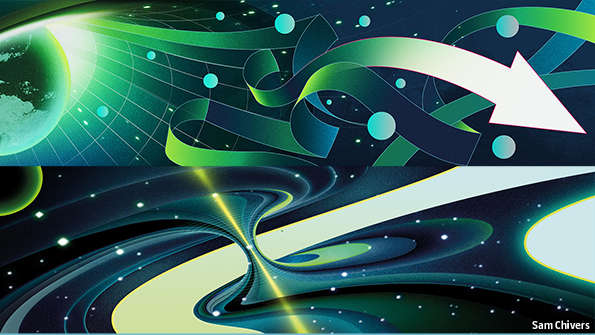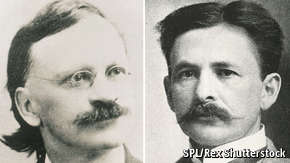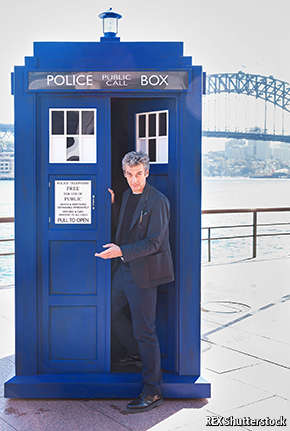Why does time pass?
The moving finger writes
In our fifth brief on scientific mysteries we ask why travelling through time, unlike travelling through space, is irreversible
.

“FUGIT inreparabile tempus.” Time flies irretrievably. But why? The question of why time flies; why it has direction; why, in other words, you cannot remember the future, is one of the most profound there is. Indeed, it is so profound that few would even think to ask it of reality.
It is, though, asked all the time in fiction. Since H.G. Wells’s novel “The Time Machine” was published in 1895, writers and dramatists have grappled with the possibility of actively travelling through time rather than merely being swept along by it. As the success of things like the BBC’s long-running serial “Doctor Who”—in which the hero travels in a time machine called a Tardis, whimsically stuck in the shape of a police telephone box—attests, that thought is one which has engaged audiences ever since.
This began to change in 1887. That was the year two American physicists, Albert Michelson and Edward Morley, tried to measure the Earth’s velocity relative to the aether, a substance in which theory then supposed that waves of light vibrate. They used an interferometer to work out the difference between light’s speed in the direction Earth was travelling and its speed at right angles to that direction. They found none. This suggests Earth’s speed is not being added to the speed of light. Since speed is distance travelled divided by time, the implication is that distance, or time, or both, are mutable.
.

It may be no coincidence, then, that Wells’s first fictional treatment of time travel, a short story on which he based the subsequent novel, was published a year after the Michelson-Morley experiment, in 1888. The elasticity of time (and, indeed, of distance), meanwhile, was confirmed, quantified and explained in 1905, by Albert Einstein, in his special theory of relativity. Starting with Michelson’s and Morley’s discovery that the speed of light is invariable, he showed that time is not a constant background tick. It is malleable, passing differently in different places, depending on how those places are moving with respect to one another. Indeed, at the speed of light, it stops altogether.
A dance to the music of time
None of Einstein’s equations, though, suggests time has an arrow. They work equally well whether you run them forwards or backwards—as did their predecessors in classical physics.
That sounds contrary to common sense. Einstein, proverbially, had little time for common sense. It is, he said, “a deposit of prejudices laid down in the mind before you reach 18.” Even so, the directionality of time is, in contradistinction to what the equations suggest, a prejudice shared more or less universally—and another branch of physics, thermodynamics, is happy with that.
Arthur Eddington was the man who, by photographing the stars surrounding the sun during a total eclipse in 1919, bolstered a crucial prediction of general relativity. This is that massive bodies such as the sun bend light as well as slowing time. Both phenomena are consequences of the fact that such bodies warp the space-time continuum, and the images of those stars nearest the sun in Eddington’s photographic plates were indeed closer to it than they would have been if their light had not been bent by the sun’s gravity.
Despite being hailed for vindicating general relativity’s equations, Eddington saw that those equations failed, where the direction of time was concerned, to mesh with everyday reality. He preferred a different explanation for this reality: one that relied on thermodynamics.
The second law of thermodynamics puts into mathematics the commonplace observation that heat flows from hot things to cold ones, and not the other way around. This mathematical treatment, though, has many consequences. One of the best-known is that any system will become more disordered as time passes. That applies as much to two gases mixing as it does to a teenager’s bedroom. This is because there are many more ways for a system to be disorderly than orderly.
That observation was made in 1877, by Ludwig Boltzmann. But it was not until half a century later, in 1927, that Eddington introduced the idea of time’s arrow:
Let us draw an arrow arbitrarily. If as we follow the arrow we find more and more of the random element in the state of the world, then the arrow is pointing towards the future; if the random element decreases the arrow points towards the past...I shall use the phrase “time’s arrow” to express this one-way property of time which has no analogue in space.
Since Eddington’s day, other versions of the arrow have been postulated: the expansion of the universe, for example, or the radiation of light waves away from a source. Deep down, though, these are all examples of systems evolving in ways that have an unmistakable direction to them.
This is also true of the arrow most pertinent to human beings, which is that you can remember only the past. Memory results from changes in the nerve cells of the brain. In this case, the result is more order in the system, rather than less. (The second law of thermodynamics is not broken here, because the heat generated by the chemistry of these changes creates counterbalancing disorder.) But the same general principle applies. Watching a brain “unlearn” things at a molecular level would look so different from watching it learn them that an observer would have no doubt which was which, and would therefore perceive time’s arrow.
No time like the present
Time’s arrow, as described by Eddington, is an emergent property. Put together lots of small things, such as atoms, for which no arrow exists individually, let them interact, and an arrow does indeed emerge. There are, however, a few, teasing examples of things that do not require emergence from complexity to reveal an asymmetry in the way time works. These involve certain sorts of subatomic particle and their antimatter equivalents.
The first to be demonstrated, in 1998, was that particles called kaons transform themselves spontaneously into their antimatter equivalents, antikaons, more slowly than antikaons make the opposite transition. The only coherent explanation of this asymmetry is that kaons and antikaons experience time differently. A similar phenomenon has subsequently been observed in B-mesons and anti-B-mesons.
These two observations show that, in special circumstances (which also involve the compensatory violation of another phenomenon, called charge-parity symmetry), the equations of time are not the same going forwards and going backwards. However, nothing is actually travelling back in time so, although these observations are of huge interest to physicists investigating the difference between matter and antimatter, they are of only marginal value to their colleagues who want to understand time’s arrow at more than just a thermodynamic level—and even, perhaps, to use that knowledge to create a real, Tardis-like time machine.
Whether such a machine is possible depends on what you want to do with it. Making one that can visit the future is quite easy, at least in principle. Making one that can visit the past is trickier.
The simplest way to travel to the future is to accelerate away from Earth in a spaceship, and then turn around and come back. Some of Einstein’s equations describe the relationship between the time experienced by two bodies, one of which is accelerating while the other is not.
They show it passes more slowly on the accelerating body. If a craft made what was, from its crew’s point of view, a 40-year journey away from Earth at a steady acceleration of 1g (speeding up for the first half of the outward leg, then slowing down, again at 1g, to reach the turning point before repeating the procedure for the return leg), that crew would find on their return that 58,000 years had passed on Earth.
Such a journey to the future would be a one-way trip. A more fantastical machine might, however, be able to manage a trip to the past as well—though the time-traveller could not go further back than the date of the time machine’s creation.
.

Einstein’s equations permit, in certain circumstances, the formation of what have come to be known as wormholes. These are shortcuts that link otherwise distant parts of the space-time continuum, creating corridors through which objects may be able to travel. If the astronauts described above carried one end of such a wormhole with them, while leaving the other behind, the end they were carrying would finish up 58,000 years in the future. If something, or someone, could then pass intact through the wormhole (a matter of dispute, but some models of reality suggest it is possible), it or he would be able to go back and forth between the two ends, traversing the millennia separating them.
The past is prologue
What remains, then, is a mystery. Theory fails to forbid travelling backwards in time. But practice suggests it might just as well be forbidden. Perhaps that is for the best. If backward time travel were possible, some fool would no doubt try testing the grandfather paradox, another invention of time-travelling fiction writers. In this, a visitor to the past kills his or her grand-father before the conception of the protagonist’s own parent, meaning the protagonist could never have been born, and the murder could not have taken place.
The grandfather paradox—the observation that causality cannot work backwards—is probably crucial to an understanding of the arrow of time. It is implicit in explanations that rely on thermodynamics and the like, but has not yet been translated into a coherent mathematical theory. For the person who does translate it, however, or who otherwise solves the conundrum of time’s arrow, a Nobel prize surely beckons.
0 comments:
Publicar un comentario